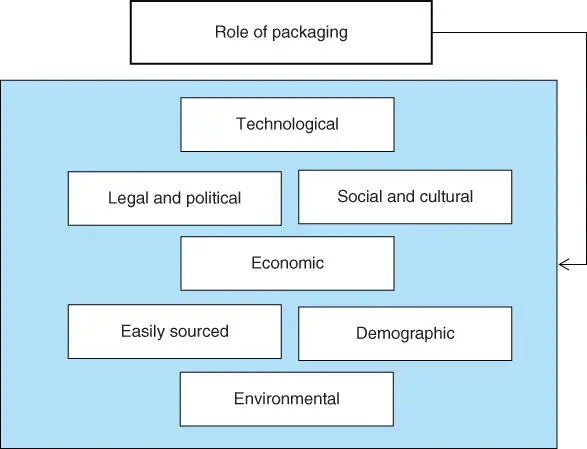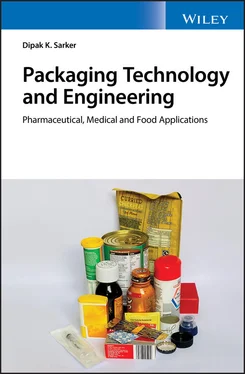1.2 Survey of Packaging Use
Consumers demand convenience from their packaging, so packages can have features that add convenience in distribution, handling, stacking, display, sale, opening, reclosing, use, and reuse. Packaging materials are used for a host of commercial product‐containment purposes. These traverse informatics and IT, such as CD or USB stick packaging, through to the diverse range of degradable (e.g. cooked meat) and non‐degradable (e.g. retorted canned fish) foods and also the protective and containing roles of packaging used for over‐the‐counter and prescription‐only medicines, surgical aids, or emergency medicines, and to safeguard the consumer against accidental consumption or contamination. Everything from furniture to garden centre compost and on to mobile phone devices is enveloped in an informative and protective sheath of packaging. In this book, topics centre on foods, medicines, and medical devices but these still account for only approximately 45–50% of global packaging use. Packaging accounts for about one‐third of the use of all polymeric materials and is by far the single biggest use of the materials. Medicine bottles and closures alone, for example, account for about one‐third of pharmaceutical packaging use.
A definition of the meaning of packaging indicates that packaging fulfils at least five roles. The first of these is the socioeconomic role of packaging; since the packaging has a value of its own this is not simply attributable to the contents being of significant value. Consequently, a good definition suggests that packaging is a precious material that protects the product within, allows the product to reach the customer in the most hygienic and safest form, and makes it easier to transport and store the product after delivery. The socioeconomic influences on packaging form are technological, political, sociocultural, availability (being at hand), ecological, economic, and demographic. Packaging has often been referred to as originating as a consequence of these socioeconomic influences, as the ‘silent salesman’, and both has managed to enter the commercial sphere and is used as a vehicle in the marketing arena in the form of the ‘8P's’ or ‘holy octet’ concept. The holy octet involves the product itself as well as aspects of pricing, placement, promotion, participant involvement, physical form, process of use, and finally a notion of personal targeting, all obtained from the idea of a malleable marketing mix to appeal to the customer [2]. The other four criteria that define packaging cover the basic functions of any packaging, which can be effectively summarised as relating to the provision of a description (information, salesmanship, and promotion) of the product, very important containment, equally important protection for storage capability, and the ability to be successfully transported or shipped across the globe.
The reasons for adherence to packaging use are manifold but are based on the ability of the materials to reduce wastage and, in doing so, because of scarcity or perishable status, reduce the product cost. A crude estimate suggests that 30–50% of ‘thrown food’ and medicinal products are disposed of because of inadequate storage; therefore, extending shelf life by a means that requires passive storage without energy consumption consequently saves energy (need for freezing/refrigeration/cooling). The pack itself also has a very important mechanical role in that it reduces damage while presenting the product in an aesthetically pleasing form. For a number of products that require a guarantee of microbial security, the pack also serves as a means to avoid pack tampering (see Chapter 8). At the same time the pack must provide information (safety, nutrition, dosage strength, mode of operation) to the customer and, therefore, aid selection or choice‐making. When well designed, a package can provide convenience, as in the case of ring‐pull or easy‐opening closures, and may in the presentation of an easily recognisable form aid the marketing of goods. However, the complexity and sheer number of layers of packaging in composite materials combined with the non‐biodegradable nature of some forms of packaging (plastic, laminated paper, glass) have contributed enormously to concerns raised over packaging persistence in the environment, unsightly littering, and global pollution. These then lead to angst over after‐use, disposal in terms of the cost, and the extent of ‘effective’ disposal or energy recovery. These more negative aspects have led to a perception of overpackaging among the general public for products such as oven‐ready foods and pharmaceutical packages.
An often misunderstood but very obvious purpose of packaging is its use in marketing and recognition, through which, by application of careful tactical and market opportunity surveillance, a specific design that means market‐leading capability can be crafted. Branding and brand identity have very powerful roles in marketing of the product (food, medicine, device) and an assurance to engage the customer. Where this is not done successfully, the best an organisation can hope for is simply market‐leader following. Consequently, all successful design considerations take into account product uniqueness, distinctiveness, and functionality; without the last a customer purchases the product only once and is discouraged by the awkwardness of the product. For pharmaceuticals and medical devices packaging is a fundamental and key part of current good manufacturing practice (cGMP) and also part of good distribution practice (GDP); cGMP and GDP are enshrined in the international standard British Standard (BS)‐European Norm (EN)‐International Organization for Standardization (ISO) 9001:2008 and are intimately associated with the assurance of quality and, by implication, safety. The stringent label requirements of packaging serve to ‘protect and inform’ the recipient with the provision of important information, such as dosing and dosage strength, adverse effects, and allergenicity, reinforced by the legal aspects of commercial activity. The form of the pack and its performance, such as ease of bottle opening or ease of dispensing of a tablet from a push‐out pack or blister pack, need to be consistent with mass manufacture and distribution, but this is not achieved without appropriate production testing and the associated higher cost of producing consistently high quality.

Figure 1.2 Survey of packaging use: the needs fulfilled by packaging.
Figure 1.2shows that the role of packaging is associated with a cluster of needs. The packaging needs include technological requirements that fit societal or speciality requirements, such as multiple opening and resealing. Legal requirements and political compliance include wastage and recycling guidelines; social and cultural requirements are also important, often mapping to creeds and cultures such as halal or kosher foods (and the guarantee of freedom from animal‐derived materials, e.g. gelatin or dairy produce). Further needs for most packaging also involve cost minimisation, which is linked to financial accessibility and economic drivers [3], and ubiquitously sourced materials with no restrictions on availability. Demographic requirements, which might include easy access or restriction‐to‐access packaging for the elderly and infants, often define the needs for some high‐risk products. Finally, and of increasingly important decision‐informing status, concerns about environmental impact, issues covering material sustainability, and efforts to recycle and reuse without impact on the anthrosphere, geosphere, or biosphere have a powerful role in product engineering and composition. All these needs amalgamate to dictate the overall requirements placed on packaging materials and their routine use in the commercial sector.
Читать дальше












